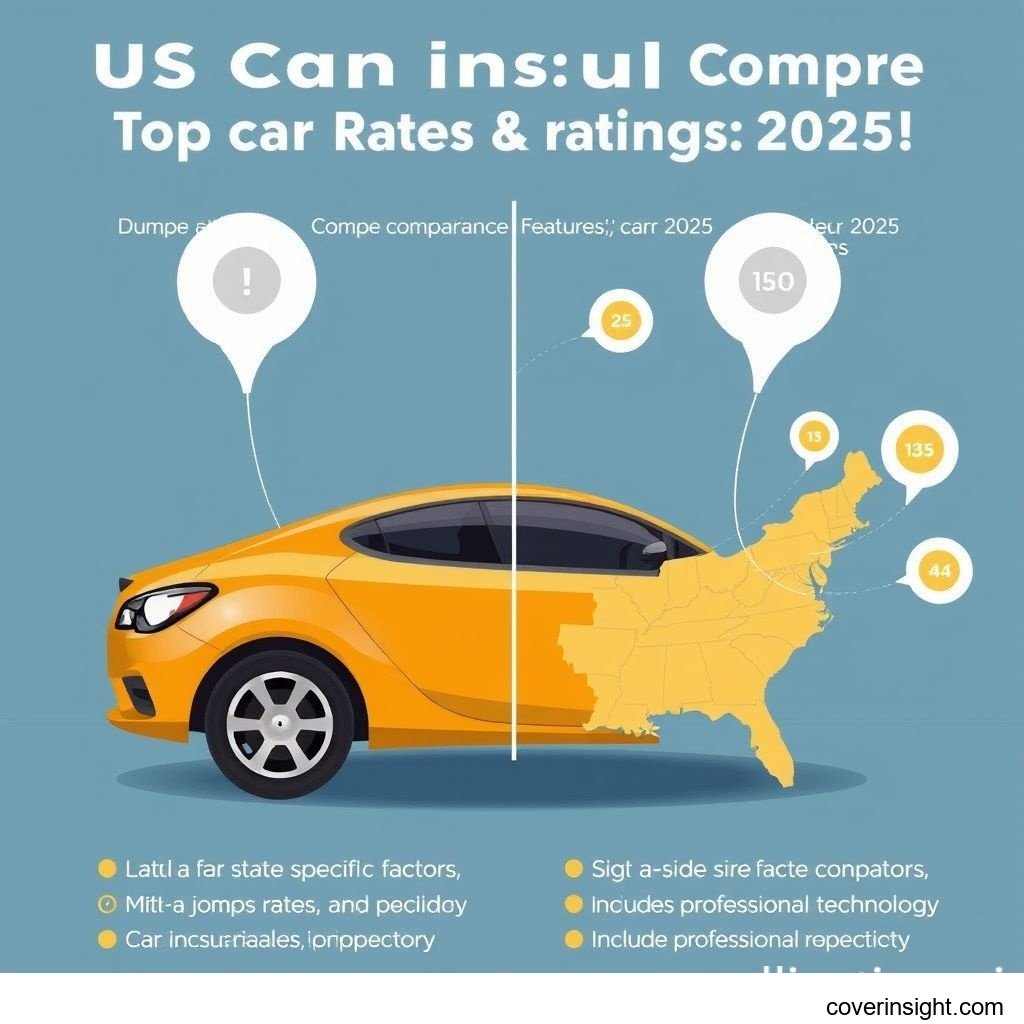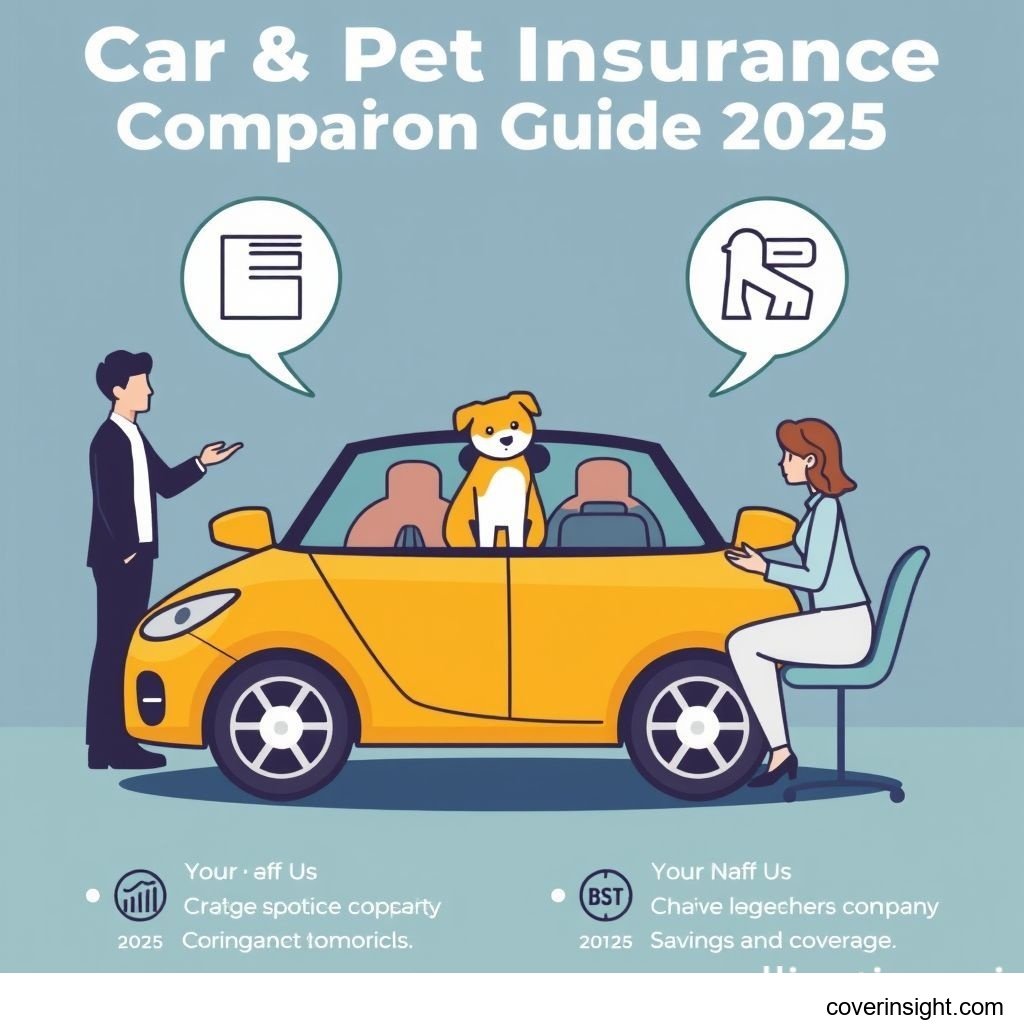Introduction
Navigating the landscape of US car insurance can seem daunting, but in 2025, understanding and leveraging effective car insurance comparisons is more crucial than ever. With rising costs and an evolving market, finding the right coverage at a competitive price requires diligence and a strategic approach. This comprehensive guide will walk you through the essential aspects of comparing top rates and ratings, ensuring you're well-equipped to make informed decisions for your vehicle protection. Effective car insurance comparisons empower drivers to secure optimal coverage without overpaying, highlighting the importance of thorough research in today's dynamic insurance environment.
Coverage Details for Car Insurance Comparisons
When engaging in car insurance comparisons, a clear understanding of what various policies include and exclude is paramount. The details of your coverage directly impact your financial protection in the event of an accident or other covered incident.
What’s Included
Most standard car insurance policies in the US offer a combination of the following key coverages:
-
Liability Coverage:
-
Bodily Injury Liability: Pays for medical expenses and lost wages of others if you are at fault in an accident.
-
Property Damage Liability: Covers damage to another person's property (e.g., car, fence, building) if you are at fault.
-
-
Collision Coverage: Pays for damage to your own vehicle resulting from a collision with another car or object, regardless of who is at fault. This is typically required if you have a car loan or lease.
-
Comprehensive Coverage: Protects your car against non-collision incidents such as theft, vandalism, fire, natural disasters (hail, floods), and impacts with animals. Like collision, it’s often required by lenders.
-
Uninsured/Underinsured Motorist (UM/UIM) Coverage:
-
UM Bodily Injury: Covers your medical bills and lost wages if you are hit by a driver without insurance.
-
UIM Property Damage: Covers damage to your car if the at-fault driver doesn't have enough insurance to pay for the repairs.
-
-
Medical Payments (MedPay) / Personal Injury Protection (PIP): These cover medical expenses for you and your passengers, regardless of fault. PIP may also cover lost wages and essential services.
Common Exclusions
While policies offer extensive protection, it's equally important to be aware of what is generally not covered. Understanding these exclusions helps set realistic expectations during your car insurance comparisons.
-
Intentional Damage: Damage caused intentionally by the policyholder is never covered.
-
Wear and Tear: Routine maintenance, mechanical breakdowns, and general wear and tear are not covered by standard policies.
-
Commercial Use: If you use your personal vehicle for commercial purposes (e.g., ride-sharing, deliveries) without a specific commercial endorsement or policy, coverage may be denied.
-
Racing or Illegal Activities: Damage incurred while participating in racing, stunts, or other illegal activities is excluded.
-
Custom Equipment: Aftermarket modifications or custom equipment may not be covered unless explicitly added to your policy with an endorsement.
-
Exceeding Policy Limits: The insurer will only pay up to the limits specified in your policy for each type of coverage. Any costs beyond these limits are your responsibility.
Cost Analysis for Car Insurance Comparisons
The price of car insurance varies significantly, making thorough car insurance comparisons essential for securing affordable rates. Many factors contribute to your premium, and understanding these can help you identify areas for potential savings.
Price Factors
Insurance companies assess a multitude of variables to determine your premium. Key factors include:
-
Driving Record: A clean driving history with no accidents or violations typically results in lower premiums. Conversely, tickets or at-fault accidents will likely increase your rates.
-
Age and Experience: Younger, less experienced drivers generally face higher rates due to a perceived higher risk. Rates tend to decrease as drivers gain experience and mature.
-
Location: Where you live significantly impacts your premium. Urban areas with higher traffic density, theft rates, or accident frequency often have higher rates than rural areas.
-
Vehicle Type: The make, model, year, and safety features of your car play a role. Expensive, high-performance, or frequently stolen vehicles usually cost more to insure.
-
Credit Score: In many states, your credit-based insurance score is a factor. A higher score often correlates with lower premiums, as insurers view it as an indicator of responsibility.
-
Annual Mileage: Drivers who log fewer miles annually may qualify for lower rates, as they are on the road less often and thus have a lower exposure to risk.
-
Deductible Amount: This is the amount you pay out-of-pocket before your insurance kicks in. Choosing a higher deductible typically lowers your premium but means more expense for you in an incident.
Saving Tips
Even with fluctuating market prices, several strategies can help you reduce your car insurance costs after conducting your car insurance comparisons:
-
Bundle Policies: Many insurers offer discounts when you combine your auto insurance with other policies, such as home, renters, or life insurance. This is often one of the easiest ways to save.
-
Increase Your Deductible: As mentioned, opting for a higher deductible on collision and comprehensive coverage can significantly lower your premium. Ensure you can comfortably afford the chosen deductible amount.
-
Look for Discounts: Inquire about various discounts offered by insurers, which might include:
-
Good driver/accident-free discounts
-
Good student discounts
-
Multi-car discounts
-
Anti-theft device discounts
-
Occupational or affiliation discounts (e.g., military, certain professions)
-
Defensive driving course completion discounts
-
-
Maintain a Good Credit Score: Regularly check your credit report and strive to improve your credit score, as it can positively influence your insurance rates in states where it's a factor.
-
Drive Safely: Avoiding accidents and traffic violations is the most effective long-term strategy for keeping your premiums low.
-
Shop Around Annually: Don't settle for your current provider without checking the market. Use car insurance comparisons tools and get quotes from multiple companies every year or when your circumstances change.
-
Consider Usage-Based Insurance (UBI): Some insurers offer programs that monitor your driving habits (e.g., mileage, braking, acceleration) via a telematics device or app, potentially rewarding safe drivers with lower rates.
Navigating the Market: Insurance Broker vs Direct for Car Insurance Comparisons
When you embark on car insurance comparisons, a fundamental decision arises: should you work with an independent insurance broker or go directly to an insurance company? Both approaches offer distinct advantages and disadvantages, impacting the ease and effectiveness of your comparison process.
Insurance Broker Advantages
Working with an independent insurance broker can significantly streamline your search for the best policy. Brokers act as intermediaries, representing multiple insurance companies rather than just one.
-
Personalized Advice: Brokers can offer tailored advice based on your specific needs, explaining complex coverage options and recommending policies from various carriers.
-
Time-Saving: Instead of you contacting multiple companies for quotes, a broker can do the legwork, providing you with several options from different insurers quickly.
-
Advocacy: In the event of a claim or dispute, a broker can act as your advocate, helping you navigate the process with the insurance company.
-
Access to Diverse Options: They have access to a wider range of policies, including those from smaller or specialized insurers you might not discover on your own through direct searches. This often leads to more robust car insurance comparisons.
-
Expert Knowledge of
insurance broker vs directmarket dynamics: Brokers are well-versed in the nuances of various insurers' offerings and pricing strategies, which is invaluable when weighing yourinsurance broker vs directoptions.
Direct Insurer Benefits
Choosing to purchase insurance directly from a single company also has its merits, particularly for those who prefer a straightforward process and direct communication.
-
Direct Communication: You interact directly with the insurer, potentially leading to faster resolution of queries or claims.
-
Online Convenience: Many direct insurers offer robust online platforms and mobile apps for quoting, policy management, and claims submission, appealing to tech-savvy consumers.
-
Potential for Exclusive Deals: Some direct insurers offer unique bundles or discounts that are only available when purchasing directly from them.
-
Brand Loyalty Programs: Building a relationship with a single insurer might lead to loyalty rewards or preferential treatment over time.
-
Streamlined Process: For those who know exactly what they need and prefer minimal interaction, direct purchase can be a very efficient way to conduct car insurance comparisons on an individual basis.
Ultimately, the choice between an insurance broker vs direct approach depends on your personal preference for guidance versus independence, and how much time you wish to dedicate to the car insurance comparisons process.
Understanding Provider Ratings and Car Insurance Comparisons
Beyond just the price, evaluating the financial strength and customer service reputation of an insurance provider is a critical component of thorough car insurance comparisons. A cheap premium is of little value if the company struggles to pay claims or provides poor support when you need it most.
How to Evaluate Companies
Several independent organizations provide ratings that can help you assess an insurer's reliability:
-
A.M. Best: Focuses on an insurer's financial strength and ability to meet its policy obligations. Ratings range from A++ (Superior) to D (Poor).
-
J.D. Power: Known for its customer satisfaction studies, which rate insurers based on claims, policy offerings, pricing, and overall customer interaction.
-
Standard & Poor's (S&P) and Moody's: Also provide financial strength ratings, similar to A.M. Best.
-
National Association of Insurance Commissioners (NAIC): While not a rating agency, the NAIC provides consumer complaint data for all insurance companies, offering insight into customer service issues. You can explore data from the National Association of Insurance Commissioners.
When conducting your car insurance comparisons, always check these ratings. A highly-rated insurer demonstrates financial stability and a commitment to customer satisfaction, which are crucial when you need to file a claim.
Top Rated Insurers for Car Insurance Comparisons
While ratings can fluctuate and depend on the specific categories (e.g., overall satisfaction, price, claims), some insurers consistently rank high across various metrics:
-
State Farm: Often lauded for its extensive agent network and customer service.
-
GEICO: Known for competitive pricing and a strong online presence.
-
Progressive: Offers innovative tools and discounts, including usage-based insurance.
-
Allstate: Provides a wide range of coverage options and local agent support.
-
USAA: Consistently top-rated for customer satisfaction, though membership is restricted to military members and their families.
Remember that "top-rated" can be subjective and depend on individual needs. Always cross-reference multiple rating sources and read customer reviews as part of your comprehensive car insurance comparisons.
State-Specific Guidance and Car Insurance Comparisons
The landscape of car insurance is not uniform across the United States. Each state has its own set of laws, regulations, and market dynamics that significantly influence coverage requirements and average premiums. Understanding these regional differences is vital for accurate car insurance comparisons.
State Insurance Market Guides
Every state dictates minimum liability insurance requirements. These vary widely, from "at-fault" states where the responsible party pays for damages, to "no-fault" states where your own insurance covers your medical expenses regardless of who caused the accident. This distinction is critical when you use state insurance market guides to understand local mandates.
-
Minimum Coverage Laws: Some states may require only modest liability limits, while others have more stringent requirements, including mandatory Personal Injury Protection (PIP) or Uninsured Motorist (UM) coverage.
-
Local Regulations: State insurance departments oversee licensing, policy forms, and consumer protection. These bodies often publish state insurance market guides specific to their jurisdiction, which can be invaluable resources for drivers. You can find detailed information on specific regulations and consumer assistance through the State Insurance Departments directory provided by the NAIC.
-
Market Competition: The number and type of insurers operating in a given state can also affect pricing. States with robust competition often see more competitive rates for car insurance comparisons.
Regional Differences in Premiums
Premiums are deeply affected by regional characteristics. Factors unique to certain areas can drive prices up or down:
-
Population Density: Densely populated urban areas typically have higher rates due to increased traffic, more accidents, and a greater risk of theft or vandalism.
-
Weather Patterns: States prone to severe weather events (e.g., hurricanes, tornadoes, hailstorms) may have higher comprehensive coverage costs.
-
Local Laws and Court Systems: The legal environment, including tort laws and propensity for lawsuits, can influence liability costs.
-
Cost of Living/Repair: Areas with higher labor costs for vehicle repairs or higher medical costs may see elevated premiums.
-
Uninsured Driver Rates: States with a higher percentage of uninsured drivers may lead to increased premiums for UM/UIM coverage for those who are insured.
When performing car insurance comparisons, always specify your exact location, as even moving a few zip codes can impact your premium significantly. Utilizing state insurance market guides is essential for understanding the unique nuances that apply to your specific area.
FAQs
Navigating the world of car insurance can lead to many questions. Here are answers to some of the most common inquiries regarding car insurance comparisons.
How much does car insurance comparisons cost?
The process of car insurance comparisons itself costs nothing. You can obtain free quotes online, over the phone, or through an independent broker. The cost refers to the actual premium you pay for the insurance policy, which varies widely based on numerous factors unique to each driver and vehicle.
What affects premiums?
As discussed, a multitude of factors influence your car insurance premiums. These include your driving record (accidents, violations), age, geographic location (zip code, state), type of vehicle (make, model, year, safety features), annual mileage, credit score (in most states), and the types and amounts of coverage you choose. Even the deductible amount you select for collision and comprehensive coverage will impact your premium.
Is it mandatory?
In almost every U.S. state, car insurance is mandatory. Most states require drivers to carry at least minimum liability coverage to operate a vehicle legally. New Hampshire is a notable exception, though even there, drivers must demonstrate financial responsibility. Driving without insurance can lead to severe penalties, including fines, license suspension, vehicle impoundment, and even jail time.
How to choose?
Choosing the right car insurance involves a multi-step approach:
-
Assess Your Needs: Determine what level of coverage you truly need (beyond state minimums) based on your vehicle's value, financial situation, and risk tolerance.
-
Gather Information: Have your driver's license numbers, vehicle information (VIN), and current policy details ready.
-
Get Multiple Quotes: Use online car insurance comparisons tools, contact various direct insurers, or work with an independent broker to obtain at least 3-5 quotes.
-
Compare Apples to Apples: Ensure you are comparing policies with the same coverage limits, deductibles, and endorsements across different providers.
-
Check Company Ratings: Look at financial strength ratings (A.M. Best) and customer satisfaction scores (J.D. Power, NAIC complaints).
-
Look for Discounts: Inquire about all applicable discounts you might qualify for.
-
Read Reviews: See what other customers say about their experiences with claims and customer service.
-
Understand Policy Terms: Before finalizing, read the policy documents carefully to understand what is covered, excluded, and your responsibilities.
Consequences of no coverage?
Driving without mandatory car insurance carries significant legal and financial consequences:
-
Fines and Penalties: Most states impose hefty fines, which increase with subsequent offenses.
-
License Suspension: Your driver's license or vehicle registration may be suspended, making it illegal to drive.
-
Vehicle Impoundment: Your vehicle could be impounded, incurring towing and storage fees.
-
Higher Future Premiums: If caught driving uninsured, you may be labeled a high-risk driver, leading to much higher insurance rates once you do get coverage.
-
Financial Liability: If you cause an accident, you will be personally responsible for all damages and injuries to others, which can amount to hundreds of thousands of dollars, potentially leading to lawsuits and bankruptcy.
-
No Coverage for Your Own Damages: Without collision or comprehensive coverage, you would bear the full cost of repairing or replacing your own vehicle after an accident or other incident.
Always ensure you comply with your state's minimum insurance requirements to avoid these severe repercussions and ensure your financial protection. Don't overlook the importance of informed car insurance comparisons to protect yourself on the road.








Comments